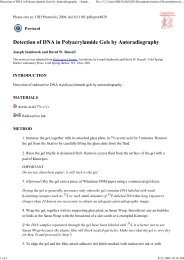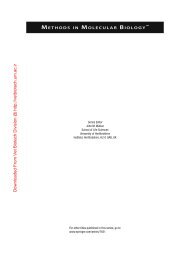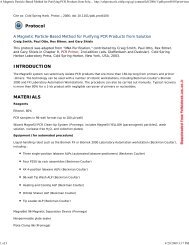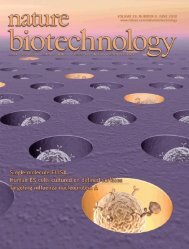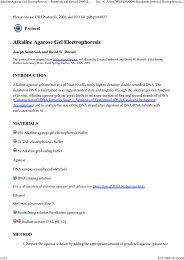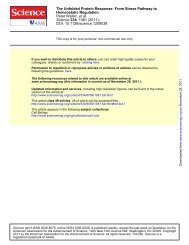COMMENTARY© 2010 Nature America, Inc. All rights reserved.Coexistence practices in non-GMagricultureWhat often gets forgotten in the heat of theGM/non-GM coexistence debate is that differentvarieties of the same crop species havecoexisted for generations and that adventitiouspresence is recognized as an inevitableconsequence of coexistence that can be minimizedbut not entirely eliminated. Therefore,almost all traded agricultural commoditiesanticipate some degree of inadvertent mixing,and thresholds exist that are recognizedin laws, regulations and/or voluntarystandards.Such thresholds have resulted in thedevelopment of a series of measures that areapplied during cultivation, harvest, transportand storage to minimize outcrossing, thegrowth of volunteer plants and inadvertentmixing 3 . These best practices were establisheddecades ago and have evolved to deliver highpurity seed and grain to support the production,distribution and trade of products fromdifferent agricultural systems. The principlesof these coexistence practices are dependenton context (which crops and where they aregrown), consistent, proportionate to need,fair and practical. Examples of successfulcoexistence practices in non-GM agricultureinclude production systems for certified seeds(e.g., hybrid seed), organic crops coexistingwith conventional crops and commoditycrops coexisting with specialty crops (e.g.,field corn with sweet corn and/or popcorn,and specialty corns such as high-amylose,high-oil, white, waxy, hard endosperm andnutritionally dense varieties) 6 .Perhaps one of the best-studied examplesof coexistence in conventional agricultureis standard rapeseed varieties and specialtyhigh erucic acid rapeseed (HEAR) varietiesfor industrial use, particularly because HEARis regarded as antinutritional and undesirablein food (and therefore constitutes an actualrisk rather than a consumer preference, as isthe case for GM crops). Contracts for growingHEAR crops require that only certifiedHEAR seed is used, equipment should becleaned and segregated and that there shouldbe an isolation distance of between 50 m (e.g.,in the UK) and 100 m (e.g., in Germany)from other rapeseed crops. The admixturethreshold for HEAR in food rapeseed is 2%although recorded levels are usually muchlower. For example, the 100-m separation distancein Germany generally delivers seed lotswith HEAR levels 0.5%. In the UK, coexistenceresearch shows that separation distances aslow as 9 m still provide bulk rapeseed harvestscontaining
COMMENTARY© 2010 Nature America, Inc. All rights reserved.Spain is arguably the most enthusiasticadopter of GM agriculture in the EU, allowingthe cultivation of GM crops without acomplete regulation regime. The establishmentof coexistence rules has been preventedby disputes between the Spanish Ministry ofAgriculture (influenced by farmers’ lobbies)and the Ministry of Environment (influencedby ecological lobbies). Coexistenceis currently determined by seed companyguidelines together with some specificregulations 12 , but there are no compulsorytraining courses, no specific liability rulesand 50-m isolation distances are standard 13 .Despite successful coexistence in Spain,market forces have created region-by-regionsegregation. In the productive agriculturalregions of Catalonia and Aragon, 55% and42% of corn, respectively, is GM 14 . In contrast,Asturias and the Basque Country havedeclared themselves GM free with the supportof regional governments and somefarmers’ associations.Several EU member states require farmersto gain official approval before they areallowed to plant GM crops. In Austria, farmersneed approval from local authorities foreach field and crop (similar procedures arebeing considered in Hungary, Ireland andthe Slovak Republic). Austria has the strictestregime, and even though there are somecoexistence measures (zero-risk seed purityregulation, compulsory training coursesand strict liability policies), the Austrianauthorities are against GM crops and striveto avoid coexistence instead of promotingit 15 . Austrian provinces have approachedthe EU to establish GM-free regions, butin September 2007 the European Court ofJustice finally rejected general statutoryregional bans on GM crops, arguing that astatutory ban is a denial of the freedom ofchoice for farmers and consumers 16 . Polandand Belgium are also seeking to avoid thedeployment of GM crops (120 communitiesin Belgium have already declared themselvesGM free). Portugal has a complete system ofregulation (established before commercialplanting) with compulsory training courses,strict anti-cross-pollination measures and apublic compensation fund. Even so, this stillallows some flexibility in isolation measuresdepending on voluntary agreements amongneighbors. This kind of collective initiativeavoids complicated anti-cross-pollinationmeasures and expensive double farmfacilities.How far is far enough?EU coexistence guidelines (Recommendation2003/556/EC) state that “…Managementmeasures for coexistence should reflect thebest available scientific evidence on the probabilityand sources of admixture between GMand non-GM crops…” 5 , but it is quite clearthat this recommendation is being ignoredin many EU member states. Some countriesrequire vast isolation distances that bear norelationship to the underpinning scientificevidence. For example, Luxemburg requires800 m between GM and non-GM corn and3 km between GM and non-GM rapeseed.Latvia requires 4 km between GM and conventionalnon-GM rapeseed and 6 km if thenon-GM rapeseed is organic (SupplementaryTable 1). Such isolation distances imposeimmense costs on GM farmers because theyhave to negotiate with a much larger numberof neighboring farms and, in practicalterms, simply remove their choice in relationto adopting GM crops 17 .The minimum isolation distances imposedon GM producers in the EU should be thosethat are sufficient to maintain the adventitiouspresence of GM material below 0.9% inneighboring organic and conventional plots.The current isolation distances were basedon the assessment of biological and physicalprocesses that affect outcrossing 3,4,18,19 , andthese tend to differ between studies if factorssuch as pollen viability; male sterility; floweringsynchrony; wind speed and direction;weather conditions; field size and shape; anddistance, topography and vegetation betweenthe pollen donor and recipient fields are notstandardized. Maize pollen is released in verylarge quantities, between 4.5 and 25 millionpollen grains per plant over a typical 5- to8-day period 20 , but is larger (90–125 µm)and heavier than the pollen of most otherwind-pollinated plants, and therefore dispersalis limited to about 10% of the range coveredby other species, often settling within afew hundred meters of its source.A research study conducted by the SpanishInstitute for Agriculture & Food Research andTechnology (Madrid) demonstrated that infield trials, the average presence of the Btgene in conventional maize separated from Btmaize by just 2–10 m is
- Page 3 and 4: volume 28 number 2 february 2010COM
- Page 5 and 6: in this issue© 2010 Nature America
- Page 7 and 8: © 2010 Nature America, Inc. All ri
- Page 10 and 11: NEWS© 2010 Nature America, Inc. Al
- Page 12 and 13: NEWS© 2010 Nature America, Inc. Al
- Page 14 and 15: NEWS© 2010 Nature America, Inc. Al
- Page 16 and 17: © 2010 Nature America, Inc. All ri
- Page 18 and 19: © 2010 Nature America, Inc. All ri
- Page 20 and 21: © 2010 Nature America, Inc. All ri
- Page 22 and 23: NEWS feature© 2010 Nature America,
- Page 24 and 25: uilding a businessComing to termsDa
- Page 26 and 27: uilding a business© 2010 Nature Am
- Page 28 and 29: correspondence© 2010 Nature Americ
- Page 30 and 31: correspondence© 2010 Nature Americ
- Page 32 and 33: correspondence© 2010 Nature Americ
- Page 34 and 35: correspondence© 2010 Nature Americ
- Page 36 and 37: case studyNever againcommentaryChri
- Page 40 and 41: COMMENTARY© 2010 Nature America, I
- Page 42 and 43: patents© 2010 Nature America, Inc.
- Page 44 and 45: patents© 2010 Nature America, Inc.
- Page 46 and 47: news and viewsChIPs and regulatory
- Page 48 and 49: news and viewsFrom genomics to crop
- Page 50 and 51: news and views© 2010 Nature Americ
- Page 52 and 53: news and views© 2010 Nature Americ
- Page 54 and 55: e s o u r c eRational association o
- Page 56 and 57: e s o u r c e© 2010 Nature America
- Page 58 and 59: e s o u r c e© 2010 Nature America
- Page 60 and 61: e s o u r c e© 2010 Nature America
- Page 62 and 63: © 2010 Nature America, Inc. All ri
- Page 64 and 65: B r i e f c o m m u n i c at i o n
- Page 66 and 67: i e f c o m m u n i c at i o n sAUT
- Page 68 and 69: lettersa1.5 kb hVPrIntron 112.5 kbA
- Page 70 and 71: letters© 2010 Nature America, Inc.
- Page 72 and 73: letters© 2010 Nature America, Inc.
- Page 74 and 75: l e t t e r sReal-time imaging of h
- Page 76 and 77: l e t t e r sFigure 2 Time-lapse li
- Page 78 and 79: l e t t e r s© 2010 Nature America
- Page 80 and 81: l e t t e r sRational design of cat
- Page 82 and 83: l e t t e r s© 2010 Nature America
- Page 84 and 85: l e t t e r s© 2010 Nature America
- Page 86 and 87: sample fluorescence was measured as
- Page 88 and 89:
careers and recruitmentFourth quart





